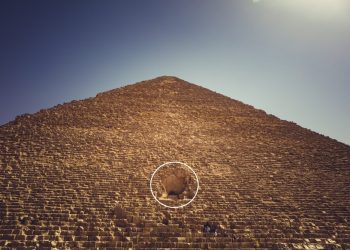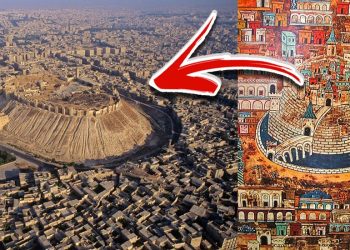The exact reason why Ancient Egyptian pyramids were built with such sophistication and precision has long-bothered experts who have studied the majestic structures for decades.
If the timeline set forth by Egyptologists is correct, then the first pyramid to be built in Egypt is the mesmerizing structure called the Step Pyramid at Saqqara. This monument was supposedly erected no later than 4,700 BC, during the third dynasty reign of King Djoser.
The Pharaoh tasked his young vizier and royal architect to go to the royal necropolis of Saqqara and build a structure that would stand the test of time.
Imhotep, the man who was given the honor, did not disappoint. In no more than 19 years, Imhotep created a monument that would end up revolutionizing ancient Egyptian architecture in ways we can’t imagine.
He designed and built what is now considered the earliest colossal stone building and the earliest large-scale cut-stone construction in Egypt.
With a total volume of 330,400 cubic meters (11,667,966 cu ft), rising towards the sky at the height of 62.5 meters (205 ft.; 119 cu.), the Step Pyramid of Djoser was a building that had never before been seen in ancient Egypt.
Built of stone, scholars agree that the social implications of such a large and carefully sculpted stone structure are staggering.
However, the Step Pyramid of Djoser was just one small part of a massive pyramid complex designed by Imhotep. The entire complex was surrounded by a massive Tura limestone wall 10.5 m (34 ft) high in addition to the surrounding temples. Interrupted by 14 doors, the wall had only one entrance.
Jean-Philippe Lauer, who excavated the Step Pyramid complex, revealed it covers 15 ha (37 acres) and is about 2.5 times as large as the Old Kingdom town of Heirakonpolis.
What lies beneath the entire complex is perhaps even a greater surprise: Before the Step Pyramid was raised, its builders excavated a shaft around 29 meters deep into the bedrock. This shaft would then be expanded into a massive subterranean world covering 5.7 kilometers in length.
Although Djoser’s successors tried replicating the incredible Step Pyramid complex, they all failed until the Fourth Dynasty King Sneferu became Pharaoh.
The Great Pyramids of Sneferu, Khufu and Khafre
Sneferu is regarded as Egypt’s most proliferate pyramid builder; he constructed three pyramids that further revolutionized Egypt’s pyramid-building techniques.
The Fourth Dynasty King is thought to have constructed the pyramid at Meidum and the two pyramids at the royal necropolis of Dahshur.
The Red Pyramid, also called North Pyramid at Dahshur, is thought to have been one of the most important pyramids built in Egypt because Egyptologists see it as the first successful smooth-sided pyramid in Egypt and the monument that laid down the necessary foundations for the construction of Egypt’s most incredible pyramid, the Great Pyramid of Giza.
Therefore, the truly gigantic pyramids of ancient Egypt are thought to have been built throughout only three generations; Sneferu, Khufu, and Khafre.
Sneferu’s pyramids alone (one at Meidum and two at Dahshur) contain more than 3.5 million cu. meters (a124 million cu. ft) of stone. All the other ancient Egyptian pyramids built by Egyptian pharaohs combined—excluding Queens’ and satellite pyramids—contain only 41 percent of the total mass of the pyramids of Sneferu, his son Khufu, and grandson Khafre.
Mainstream Egyptologists maintain that after Sneferu’s reign, his son Khufu took the throne. Immediately afterward, he commissioned what would become the most impressive of all Egyptian pyramids. Believed to have been built with more than 2.3 million stone blocks and a total weight of around 6.5 million tons, the Great Pyramid of Giza is the jewel of ancient Egyptian pyramid-building techniques.
Its size and height are perhaps hard to grasp, but even more so is its accuracy. Egyptologists maintain that the base of the Great Pyramid of Giza is level to within just 2.1 centimeters (under 1 inch); the average deviation of the sides from the cardinal directions is 3’6” of arc; the greatest difference in length of the sides is around 4,4 centimeters (1.73 inches).
Why such phenomenal precision was embedded within the Great Pyramid of Giza has troubled experts for decades.
Mark Lehner maintains that for the pyramids’ royal designers, such exactitude may have been imbued with symbolic and cultic significance that now eludes us. However, a more practical explanation is that it may have been a response to the architectural disasters that builders went through during the construction of the Bent Pyramid at Dahshur.
Interestingly, the Pyramid’s precision was unmatched by their cosmic precision.
Egyptian Pyramids Align With Ancient North Star
Scholars theorized that a star now referred to as Thuban may have served as the north star for the ancient Egyptians.
Today, according to NASA, this ancient North Star is, in fact, a pair of stars that eclipse one another.
This binary system may have been of great importance to the ancient Egyptians.
Thuban can be easily spotted in a clear night sky, located right between the bowl of the Little Dipper and the handle of the Big Dipper.
Ancient Egyptian astronomers probably held the star(s) in high regard in ancient times.

Astronomers and modern scholars suggest that some 4,700 years ago, as the Egyptians of the Third Dynasty were building the first pyramids, Thuban—an extremely bright star— was likely the axis around which all other stars seemed to spin when observing the night sky.
Therefore, it is why some scholars argue the pyramids of Egypt were erected to point toward Thuban directly, denoting its importance in ancient Egyptian cosmology.
Four thousand seven hundred years later, the North Star is Polaris, a much brighter star than Thuban, located to its right. This is because Thuban’s position has changed over time due to the tilt of Earth’s axis and where it points to. In other words, since Earth’s axis wobbles and shifts over time, the North Star is now Polaris and not Thuban.
Also known as Alpha Draconis, the star is located around 270 light-years from Earth in the constellation of Draco. The Star, which is actually a binary system, was observed by NASA’s Transiting Exoplanet Survey Satellite (TESS), thanks to which astronomers found that it and its fainter companion star eclipse, or pass in front of each other from Earth’s perspective, every 51.4 days at an average distance of about 38 million miles apart.
When the pyramids of Egypt were built—during Djoser’s reign—the star that was clearly visible to the naked eye was the closest star located near our planet’s geographic north pole, precisely where Earth’s axis of rotation intersects with the surface.
Join the discussion and participate in awesome giveaways in our mobile Telegram group. Join Curiosmos on Telegram Today. t.me/Curiosmos











